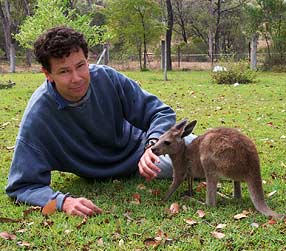Meet the Experts: Barry Traill, Director, Wild Australia Program
 Barry Traill joined the Pew Environment Group in 2007 as director of the Wild Australia Program, a joint program of Pew and The Nature Conservancy. He works with partner organizations to obtain protection for large wilderness areas in Australia on land and sea.
Barry Traill joined the Pew Environment Group in 2007 as director of the Wild Australia Program, a joint program of Pew and The Nature Conservancy. He works with partner organizations to obtain protection for large wilderness areas in Australia on land and sea.
Q: What were some influences that caused you to develop a passion for protecting the environment?
A: I always loved being with wildlife. As a child, my family got used to me having wild things in my bedroom and storing interesting specimens behind the ice-cream container in the refrigerator. By the time I was a teenager, I had spent a lot of time in the countryside—what we call the “bush” in Australia—and knew I wanted to have a life committed to wildlife and conservation.
Q: What have been some of your greatest challenges?
A: The toughest was in the 1990s, when I moved from a job with a land trust back into advocacy. I was a volunteer, starting a national campaign to protect woodlands across Australia. I had a new daughter, and my partner, Susie, wasn't doing paid work, so it was a risk for the family. It produced some times of great uncertainty. But it worked. We established and helped build up several powerful conservation campaigns. This included the biggest win in Australian environmental history: protecting around 50 million acres from being bulldozed in the state of Queensland.
Q: What do you like about the work you do now?
A: I get to help protect huge chunks of Australia's land and sea. I especially like having a full toolbox of approaches to use in the Wild Australia Program, which is Pew's joint initiative with The Nature Conservancy. These approaches range from advocating for stronger environment legislation to supporting Indigenous-owned land parks. And in my work, I get to see some of the most stunning landscapes and amazing wildlife on the planet, often while traveling with the Aboriginal owners who know it best.
Q: Tell us about landscape-scale conservation—specifically, what is the genesis of this approach, and how has it been beneficial in its application to Wild Australia's work in Northern Australia and the Channel Country?
A: In landscape protection, the bigger, the better. A lot of wildlife has to move around to find food and water, and often over huge distances. Creating a scattering of national parks can help, but recent science shows that you need to look after the landscape as a whole to maintain how the landscape works best. This idea—known as landscape-scale conservation—means, for example, that birds in Australia can still find a refuge during a drought, and caribou in Canada are able to follow their ancestral migration routes.
This doesn't mean that every place needs to become a national park. But it does mean that you ideally need a significant amount of landscapes in conservation parks, with the remainder managed in a way that is compatible with conservation. To achieve this, you usually need to bring together lots of different partners to find solutions: conservation groups, Aboriginal landowners, industry and government. This approach informs our work in places such as Northern Australia and the Channel Country region of the country, as it does the great work by Pew campaigners in other huge wild regions such as the Canadian boreal forest.
Resource File: Thinking Big to Protect Australia's Outback






